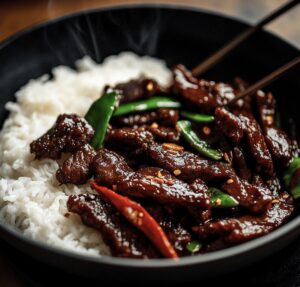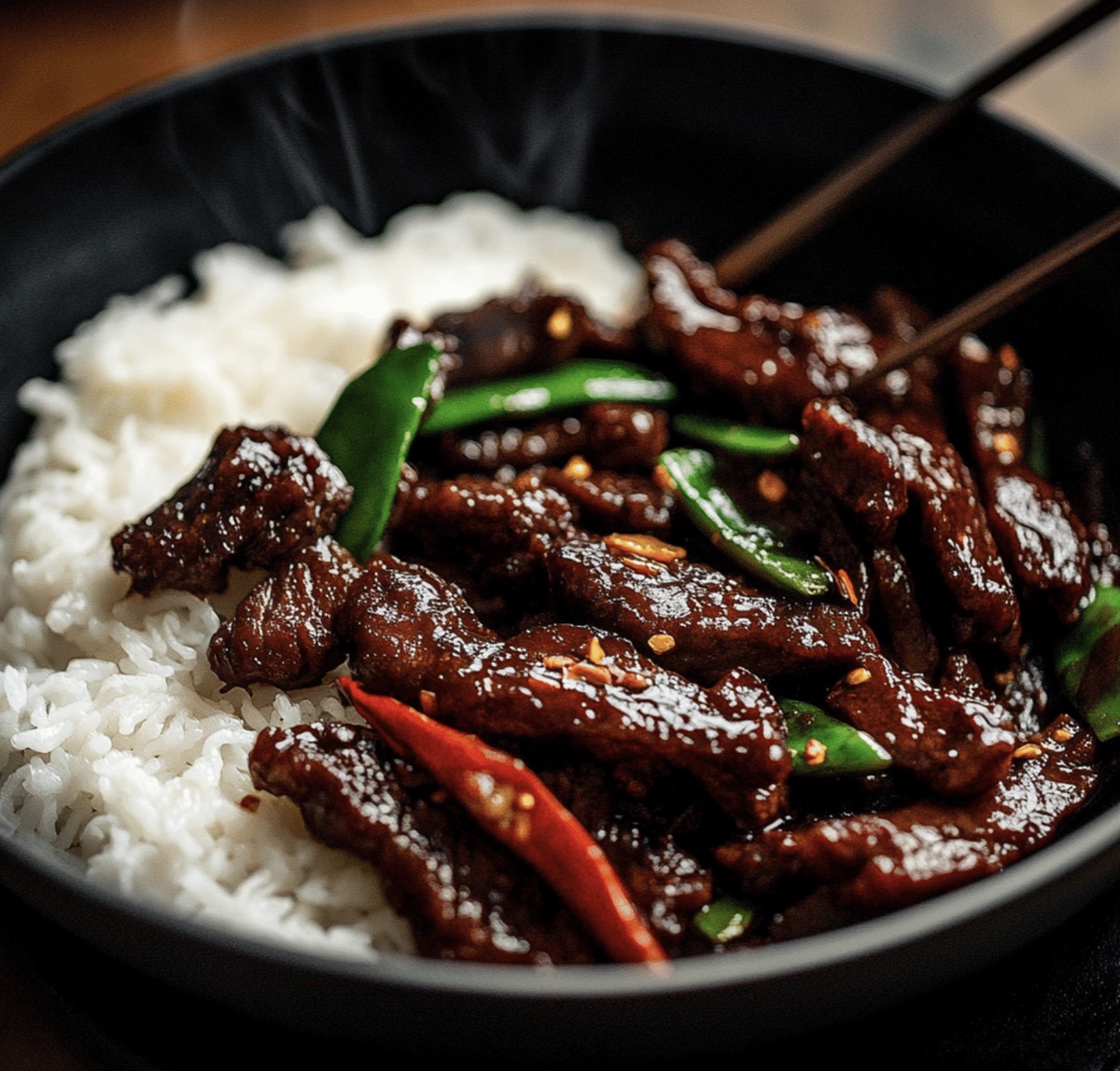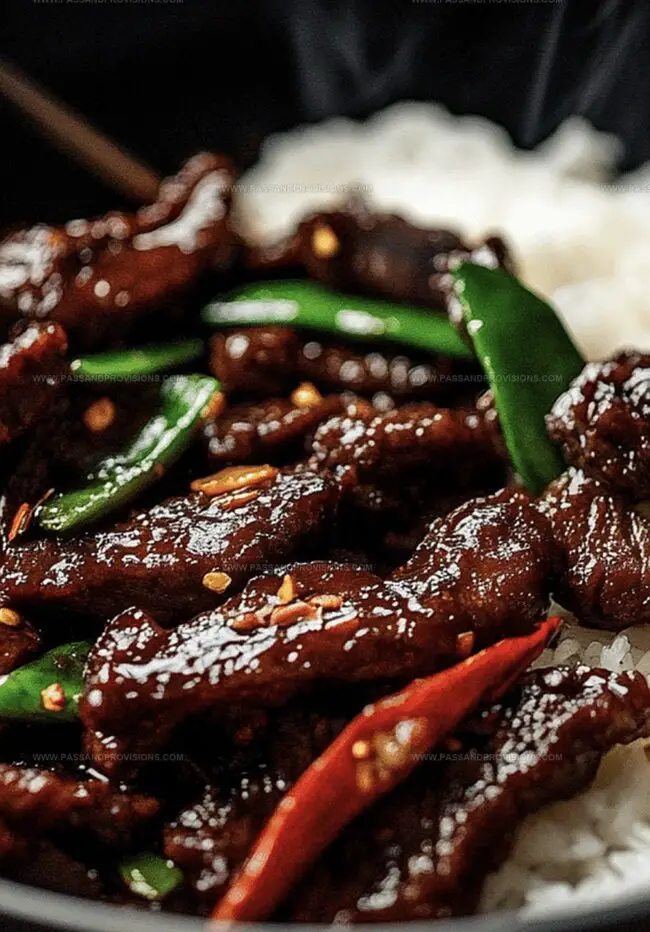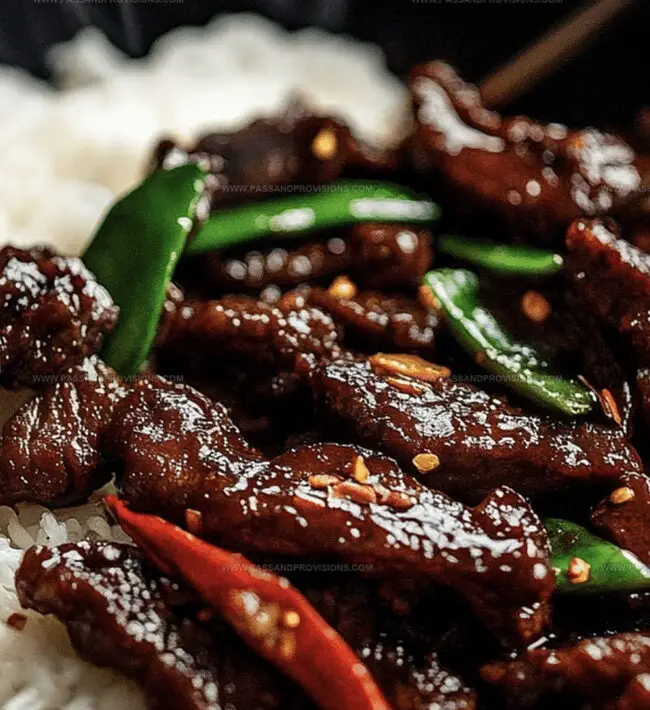Sizzling Mongolian Beef Recipe: Tender & Flavorful Magic
My kitchen adventure with this mouthwatering mongolian beef recipe started unexpectedly during a late-night craving for something bold and spicy.
Memories of street food in bustling markets inspired me to recreate those incredible flavors at home.
Tender strips of beef dance in a glossy, caramelized sauce that promises intense satisfaction with every bite.
Fragrant garlic and green onions add depth and complexity to this classic Asian-inspired dish.
Simple ingredients come together in a remarkable symphony of taste that will surprise you.
Cooking becomes an art form when you master these delectable flavor combinations.
Let’s transform an ordinary evening into an extraordinary culinary experience that will have everyone asking for seconds.
Why This Mongolian Beef Recipe Is a Favorite
Ingredients List for Mongolian Beef
Main Protein:Coating and Thickening:Sauce and Seasoning:Instructions for Cooking Mongolian Beef
Prepare Tender Beef Strips
Slice beef into thin, diagonal strips against the grain to ensure maximum tenderness. Cut each slice about the width of your pinky finger for perfect bite-sized pieces.
Coat Beef With Cornstarch
Place beef in a large bowl and sprinkle cornstarch over the meat. Gently toss and massage the cornstarch into each strip, creating a light, even coating. Let the coated beef rest for 10 minutes, which helps create a crispy exterior and allows the cornstarch to absorb moisture.
Mix Flavorful Sauce
Whisk all sauce ingredients in a separate bowl until the brown sugar dissolves completely. The combination creates a perfect balance of sweet, salty, and tangy flavors that will make your Mongolian beef irresistible.
Sear Beef To Perfection
Heat a large wok or skillet over high heat. Add a splash of oil and wait until it shimmers. Carefully place beef strips in a single layer, allowing each piece to develop a golden-brown crust. Work in batches to prevent overcrowding and ensure even cooking.
Create Glossy Sauce Coating
Pour the prepared sauce into the pan with the seared beef. Stir quickly to coat each piece, letting the sauce reduce and create a glossy, sticky exterior. The sauce will thicken and cling to the crispy beef strips.
Garnish And Serve
Sprinkle chopped green onions over the beef for a fresh, sharp contrast. Serve immediately over steamed rice, allowing the sauce to drizzle and create delicious pools around the meat.
Tips for Tender, Flavorful Mongolian Beef
Reheating and Storage for Mongolian Beef Leftovers
What Complements Mongolian Beef on the Table
Tasty Variations for Mongolian Beef
FAQs on Mongolian Beef Recipes
Cutting against the grain means slicing the meat perpendicular to the muscle fibers, which makes the beef more tender and easier to chew.
Cornstarch helps create a crispy exterior on the beef, prevents the meat from becoming tough during cooking, and thickens the sauce, giving it a glossy and smooth texture.
Flank steak or sirloin work best, but you can also use ribeye or New York strip steak. The key is to choose a lean cut with visible muscle fibers that can be easily sliced thin.
Cook the beef quickly over high heat until it’s just browned on the outside and still slightly pink in the center, which usually takes about 2-3 minutes. This ensures the meat remains tender and juicy.
Print
Mongolian Beef Recipe
- Total Time: 25 minutes
- Yield: 4 1x
Description
Sizzling Mongolian Beef promises a flavor explosion of tender meat dancing with savory-sweet sauce. Succulent strips of beef caramelize perfectly, delivering an irresistible culinary journey that will transport diners straight to bold Asian cuisine’s heart.
Ingredients
Protein:
- 1 lb (454 grams) flank steak (or sirloin), thinly sliced against the grain
Sauce and Seasoning Ingredients:
- ½ cup (120 milliliters) low-sodium soy sauce
- ¼ cup (50 grams) brown sugar (light or dark)
- ½ cup (120 milliliters) beef broth (or water)
- 2 teaspoons (10 milliliters) sesame oil
- 1 tablespoon (15 milliliters) hoisin sauce (optional, adds depth)
- 1 teaspoon (5 grams) ginger, grated
- 3 cloves garlic, minced
- ½ teaspoon red pepper flakes (optional, for heat)
Coating and Thickening Ingredients:
- ¼ cup (30 grams) cornstarch
- 2 tablespoons vegetable oil
- 1 tablespoon cornstarch + 2 tablespoons water (for thickening)
Garnish:
- 2 green onions, sliced
- 1 teaspoon sesame seeds
Instructions
- Carefully slice the beef into delicate, paper-thin strips, ensuring each cut follows the natural grain of the meat for maximum tenderness.
- Generously coat the beef strips with cornstarch, creating a light, even dusting that will help develop a crispy exterior and contribute to a luxurious sauce consistency.
- Allow the cornstarch-covered beef to rest for a brief 10-minute interval, permitting the coating to adhere and prepare for optimal cooking.
- Heat a wok or large skillet to high temperature, ensuring the cooking surface is scorching hot to achieve a perfect sear on the meat.
- Swiftly introduce the beef to the sizzling pan, arranging the strips in a single layer to guarantee rapid, even caramelization.
- Cook the beef in quick, dynamic movements, flipping and stirring to create a golden-brown crust while maintaining the meat’s internal juiciness.
- Rapidly introduce the vibrant sauce ingredients, coating the beef in a glossy, rich glaze that balances sweet, savory, and umami flavors.
- Continue tossing the beef in the sauce until every morsel is thoroughly glazed and heated through, creating a harmonious blend of textures and tastes.
- Remove from heat immediately to prevent overcooking, preserving the beef’s delicate tenderness and preventing rubberiness.
- Garnish with a sprinkle of fresh green onions and sesame seeds for a final touch of color and aromatic complexity.
Notes
- Slice beef against the grain to ensure tender, melt-in-your-mouth pieces that are easy to chew and cook quickly.
- Cornstarch coating creates a protective layer that locks in moisture, preventing the meat from becoming tough and generating a beautiful crispy exterior.
- For a healthier version, swap beef with chicken or tofu and use low-sodium soy sauce to reduce salt content without compromising rich flavor profiles.
- Allow meat to reach room temperature before cooking to guarantee even cooking and prevent tough, chewy texture that can happen when cold meat hits a hot pan.
- Prep Time: 10 minutes
- Cook Time: 15 minutes
- Category: Dinner
- Method: Frying
- Cuisine: Mongolian
Nutrition
- Serving Size: 4
- Calories: 383
- Sugar: 10 g
- Sodium: 710 mg
- Fat: 18 g
- Saturated Fat: 3 g
- Unsaturated Fat: 15 g
- Trans Fat: 0 g
- Carbohydrates: 37 g
- Fiber: 1 g
- Protein: 24 g
- Cholesterol: 70 mg




Jamie Granger
Recipe Developer & Food Writer
Expertise
Education
Culinary Institute of America
Jamie Granger turns ingredients into memories. With her recipes, she brings a fusion-forward flair to every creation.
Her dishes reflect the places she’s explored, the chefs she’s learned from, and the deep connection she has to food as a form of expression.
At Pass and Provision, Jamie develops recipes that balance flavor, health, and beauty, meals that don’t just satisfy your appetite but speak to your curiosity.